 Here’s a peek at the Moore College exhibit “Philadelphia Selections 5” curated by Director of Exhibitions, Brian Wallace. For more Moore, see my piece in PW coming this Wednesday.
Here’s a peek at the Moore College exhibit “Philadelphia Selections 5” curated by Director of Exhibitions, Brian Wallace. For more Moore, see my piece in PW coming this Wednesday.
One reason to go see an exhibit when it’s being installed (if you get clearance for such) is to talk a little with the artists or curators and get behind the scenes information that often helps elucidate the work. It’s also fun to see the mess created by artists installing. This is especially reassuring if you happen to be a little messy yourself. Ahem.
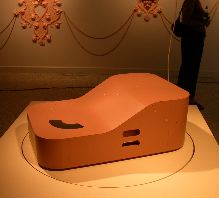
But you must always go back and see the show again once it’s installed because sometimes things change.
For example, the top image, Ephraim Russell‘s “Dimensionator,” (at least I think that’s its name) sits in the show on a turntable that spins slowly. The piece provides digital readouts of something or other just waiting to be of use to someone…for something.
It’s a great piece. But it’s not what I saw spinning around when I stopped by the day before the show opened. Image right above was the sleek module I saw spinning on the turntable. Curator Wallace had made a last minute substitution.
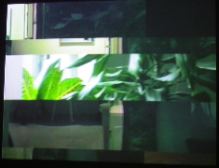
This is a very good exhibit. All the Philadelphia artists represented make you proud to be a Philadelphia artist. As with many group shows, there’s something for all tastes. My taste drew me immediately to Nadia Hironaka‘s new video “Home,” an elegant, lovely, meditative piece that proceeds at a slow pace for half of its nine minutes then hold on, starts to split apart into horizontal bands of imagery and sound which keeps you glued to your seat as if watching an indoor aurora borealis. (right above is detail) More, I wanted more. Wallace told me Hironaka was experimenting. She’s on to something great. “Home” is a must see piece.
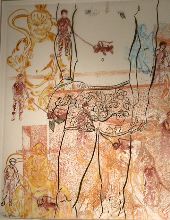
I told you about the many stealth works in “Open” at Arcadia. (see posts one and two) I had just come from that show when I saw this one for the second time. Guess I was not expecting stealth. But I found it in spades. In fact, I found it late, after studying my photos. Daniel Heyman‘s “Untitled (from War Series)” a four-panel acrylic and gouache on vellum work made me scratch my head. The work is so lovely and lyrical I wondered why it was from a war series. In fact, the artist has inserted into the swirling world of figures, fish, kimono wearing geishas and such, repeat imagery from the Iraq war. Specifically, those Abu Graib photographs of torture. You must look hard to see them. This piece, while completely different in affect, shakes hands with M. Ho’s prettied up newspapers in Mixmaster Universe. See my previous post for more on that.
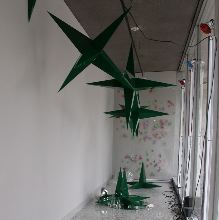
Arden Bendler Browning, Steven Baris, James Johnson, Rain Harris, Elizabeth Rywelsi and Bekhyon Yim also make good strong statements here. I’ll hit them later in the week. For now, I’ll leave you with Joy Feasley and Aaron Igler‘s “The Rayleigh Scatterers,” a piece of audio and visual happiness. Igler, a sound guy, has wired up some audibles which play a haunting, romantic piano piece heard throughout the gallery. It called me like a siren’s song to the piece’s spot in the window well. Once there, you see Feasley’s large green plexiglas crystals hanging and sitting in splendor. They look great. And you see a stand up xylophone just waiting to be played. Do not hesitate. I picked up those mallets and plunked away. Even with no musical talent, you can make pretty music with that xylophone. Highly recommended.
The mess of electrical cable on the floor is kind of distracting but I walked into the space and am glad I did. In one corner on the floor of this crystal-crazy installation are a group of cast glass paper weights (found objects says the checklist). Entrapped in the small glass objects are things from nature — a flower for example or — a scorpion. I looked closely and found the scorpion sitting atop a logo from Allis Chalmers.
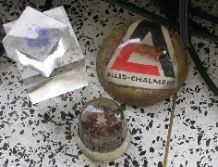
Now that won’t mean anything to you. But it was midwest voodoo again for me.
Allis Chalmers is was the biggest employer in the Milwaukee suburb called West Allis (because it’s west of Allis Chalmers — midwesterners are literal). Scorpions are not indigenous to West Allis but maybe they’re the mascot of Allis Chalmers. I don’t know. AC, which doesn’t exist anymore, due to rustbelt/sunbelt dynamics) made big heavy machinery — tractors and such. My encounter in the gallery with the odd scorpion/AC found object — which must belong to Feasley or Igler — made me think about how small the world is and about how objects — and people — make serendipitous connections.
If you’re getting sick of midwest voodoo just let me know and I’ll try to contain myself.









